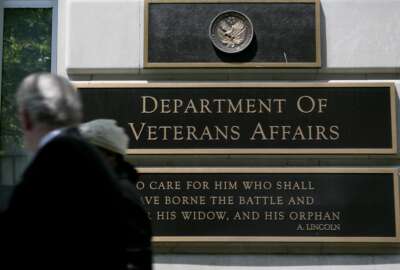VA initiative looks to fill shortage of medical practitioners in rural areas
Veterans in rural areas often have to deal with a shortage of medical practitioners — a new Veterans Affairs initiative is aiming to fix that.
Best listening experience is on Chrome, Firefox or Safari. Subscribe to Federal Drive’s daily audio interviews on Apple Podcasts or PodcastOne.
Not everyone lives in a city. Those in rural areas often have to deal with a shortage of medical practitioners. That includes veterans. The Veterans Affairs Department has launched a workforce development initiative to try and correct this problem. For more details, the executive director of VA’s Office of Rural Health, Dr. Thomas Klobucar joined Federal Drive with Tom Temin in studio.
Interview Transcript:
Tom Temin: Give us a sense of the scope of the problem in terms of what the VA needs in the rural areas and what it’s actually got at this point.
Dr. Thomas Klobucar: Well, you know, the problem isn’t just for the VA. The There’s a nationwide shortage in providers in rural areas, while 20% of our population lives in rural areas, only about 9% of the providers choose to practice in rural areas. So it’s a significant shortage, and it’s not just a problem for VA. For the V.A veteran’s about 33% of our total veteran population that’s enrolled in the
VA for healthcare lives in rural areas, and so there’s a significant level of dependence on VA for care
with more than half of those folks enrolled in VA for healthcare, half of the rural veterans. So
it’s a significant issue that we’re trying to address in a couple of different ways.
Tom Temin: Let me just ask you this first just briefly, how do we define rural?
Dr. Thomas Klobucar: That is a great question. There’s a lot of different definitions for rural out there. I think it’s the best way to think of rural is something that’s not urban, and I know that sounds like an oxymoron, I guess. But the fact of the matter is that when you have a town of 50,000 or 40,000 or more that’s considered an urban area, everything else that it doesn’t comprise those urban areas is considered rural. Now there’s also a designation we call highly rural and generally speaking, that’s where the population is about fewer than seven people per square mile. So some of these distances that we’re talking about in these rural areas are significant. In the VA we use what we believe is the good quantitative system for making those determination called rural urban commuting areas, and that has to do with what kind of service is available in a community that helps us make that determination, whether they’re rural or urban.
Tom Temin: Yeah, because you could be in somewhere like Poolesville, Maryland, which looks like farm country. But you’re still very quick, you can be in Baltimore or D C, in a matter of, you know, half an hour or a helicopter ride of 10 minutes. So it looks rural, but it’s not what you really mean right?
Dr. Thomas Klobucar: We think of that more as an exurban area. In other words, you can reach the service’s quickly, and they’re all available to you.
Tom Temin: So VA then has a shortage of people, medical practitioners. This includes doctors also nurses and people related to the physicians.
Dr. Thomas Klobucar: Absolutely right it is, it’s across the board. Our most acute shortages is in the area of mental health providers in rural areas. There’s a significant number of all rural counties in the United States that have absolutely no mental health providers available in those communities. So
it’s an acute problem, not just for primary care providers, not just for specialty care physicians, but in nurses, physical therapists, mental health providers across the board.
Tom Temin: What sort of infrastructure does the VA have in terms of centers in those areas?
Dr. Thomas Klobucar: About half serve mostly rural veteran populations. A lot of veterans in rural areas drive into urban areas to visit VA medical centers. We have about 170 VA medical centers across the board in VA and 800. some clinics and 450 of those clinics approximately are located in rural areas. So we’re trying to attack the problem there. But an important leg of the stool that comprises VA health care are our partners in community care. VA turns to the community to help our veterans to deliver the care they need in their rural communities, whenever that’s possible, if there’s not VA facilities available.
Tom Temin: So the shortage of people then also affects the ability to carry out the Mission act?
Dr. Thomas Klobucar: It certainly has an impact. But it’s something that we’re trying to address using our community care partner, using technology through telehealth, where we we actually can deliver care over distance from urban areas or rural areas to highly rural areas, or to rural areas for our veterans so that we can deliver this care electronically via the internet.
Tom Temin: So tell us about the initiative, the workforce development that you’re trying to help get these clinicians into the rural areas.
Dr. Thomas Klobucar: So you know, it’s an interesting question because there’s a significant amount of speculation about what makes citizens conditions wanna work in rural areas of the country, we have a significant research effort devoted to finding out the answers to those questions. People stay in rural for a lot of different reasons. For the environment, for the safety, for the schools and
so on and so forth. So in VA we’re trying to understand those reasons better so that we can apply our VA efforts in those different areas. One of the things we know is when we get providers, we certainly need to try to keep those providers because turnover is an issue in any industry. So one of the things we do is try to create for these rural providers a sense of connectedness to their urban counterpart. So through programs like inter-professional faculty development programs, where we actually train rural providers to be faculty at associated medical schools and then they can train students at their
rural facilities in the hopes that if you train in rural, you’ll stay in rural. But in any event it increases. It has a two-fold kind of payoff, not only do you get more students trained in rural, you get a feeling of connectedness with their clinical community among our providers, so that’s a really important effort we have. We also use virtual links to conduct training for our rural providers. For example, in rural America, there’s a definite shorter’s in the area of OBGYN. We have an effort underway that provides in person training, clinical skills training for women’s veteran healthcare so that our primary care providers in rural can be trained to deal with the challenges that our rural women face as well. So
there’s those programs plus the programs that around tuition reimbursement, student loan reimbursement that our Workforce Management office runs through those programs. We hope to really tackle this problem.
Tom Temin: Sounds like some people that may have gotten their medical education or their training and development in rural areas maybe just need to understand some of the virtues of living in rural America, and those are real.
Dr. Thomas Klobucar: You bet. As an 18 year resident of the great state of Iowa myself, I can say that there’s a lot of advantages to that. And that’s one of the things that we try to point out to our potential employees. And certainly to help sustain our current workforce.
Tom Temin: Is the feeling that telemedicine can simply substitute for someone local? I mean, in the area of mental health, more and more people are doing this in a tele manner, thanks to the video connections and face time and all of these things. But in the final sense, is it really a good substitute?
Dr. Thomas Klobucar: You know, there’s a lot of things we can do with tele-medicine. We can deliver primary care over that. Mental health as you suggested, that that is our largest user. Our mental health service’s and our veterans getting mental health service’s. But there are many areas of specialty care that we get in we can deliver via tele-health. Telehealth is really important, but it’s part of the solution. It’s not the entire solution, because in the final analysis, there has to be a provider on the other end of that telehealth link. And so that’s why we focus not just on technology, but we also focus on the people.
Tom Temin: Another technologically related question which affects the people, is the bandwidth in rural areas. Because if you’re gonna move images say, taken locally to get analyzed further out and maybe the results come back or you need that video type of connection, the bandwith becomes a real issue in some areas.
Dr. Thomas Klobucar: That is absolutely a significant challenge. And it’s something we’re working with the U.SDA world utility service with the Federal Communications Commission to try to encourage investment by our partners in creating bandwith solutions for rural areas. It’s mostly not. our facilities. Our facilities are plugged in and even our community partners facilities are plugged in. But it’s when you start to try to deliver care into the home, on an iPad or a tablet or phone. It’s when you do that that that bandwith access becomes critical in rural areas. And we know just from our own data analysis, working with the FCC, that there’s about 3 or 400,000 veterans that are enrolled in the VA that cannot access the internet in their homes simply because there’s no Internet access available to them. So we’re working with our partners to try to address some of those issues. But there are alternatives and local community libraries. And in local, for example, we have new initiatives installing telehealth equipment and telehealth pods in WalMart and veterans service organizations. So we’re searching for solutions that can address some of those geographic challenges using this modern technology while still trying to address the gaps that there are in United States across the board.
Tom Temin: What about local Defense Department facilities? Not so much to provide the health, but to provide the facilities or the place to go to get that bandwith in those installations.
Dr. Thomas Klobucar: We have a really strong partnership with the Department of Defense and the Defense Health Agency, and we’re already partnering in a lot of different ways with Defense Health Agency institutions that are taking care of veterans and and we have VA facilities that are taking care of some active duty military. So, yeah, there’s definitely a symbiotic relationship there where both sides are able to benefit their constituencies.
Tom Temin: Sounds like the rural question is one you’ll never say we’re done, it’s all solved. That sounds like something that is gonna be ongoing pretty much indefinitely.
Dr. Thomas Klobucar: I think that’s true. I have to say that even a lot of our counterparts in Europe have not dealt with this effectively. The idea of delivering care in rural and getting care to where those veterans live and in their communities, that’s the care they’ve earned. And it’s going to continue to be a challenge for the Department of Veterans Affairs. But I’m convinced that we have the approaches and the resources to get us there.
Tom Temin: Thanks so much for joining me.
Dr. Thomas Klobucar: It’s been great, thank you so much.
Copyright © 2025 Federal News Network. All rights reserved. This website is not intended for users located within the European Economic Area.
Related Stories




